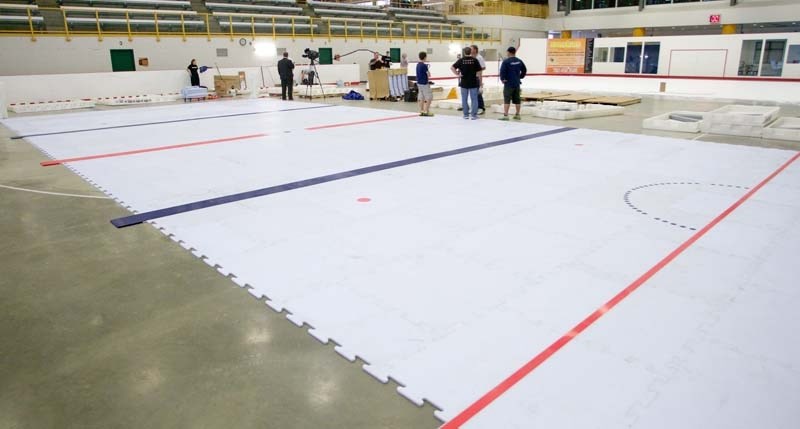Ice time is a hot commodity in St. Albert, which is why the local minor hockey association is testing out an alternative.
Together with the City of St. Albert, the St. Albert Minor Hockey Association (SAMHA) has set up a 12-day evaluation period of two different synthetic ice manufacturers at the south fieldhouse in Servus Place until Sept. 11.
The trial period will determine if synthetic ice technology can provide a skating surface comparable to regular ice that meets the needs of not only hockey players but also figure skaters, ringette and sledge hockey players.
SAMHA put fourth the idea of a synthetic ice trial before council in July as a possible solution to over-booked rinks and an alternative to building another arena.
For the 2012-2013 hockey season, SAMHA purchased approximately 85 hours of ice time per week outside of St. Albert, adding up to $461,550 in costs. During the same year, St. Albert Ringette spent $39,000 for outside ice time.
“There’s a cost justification there right away,” noted SAMHA president Dave Bell, adding that although the association may not be able to completely eliminate ice time outside of St. Albert, even cutting the number in half would be beneficial.
Synthetic ice is made of special polymer or plastic links that are interlocked like puzzle pieces to create a large gliding surface. Both suppliers showcasing their product at Servus Place – Eclipse Sports based in Cambridge, Ont. And SmartRink out of Dartmouth, N.S. – use different grades of polyethylene.
Bell explained players will usually react cautiously to the artificial ice when they first come across it.
“These guys equate it to going to the lake and dipping your toe in the water,” he said.
Although the points of contact between ice skates and the synthetic ice surface are similar to those of regular ice, the plastic creates more resistance.
“It’s a little more drag, a little more stickiness,” acknowledged Bell. “But if you look at the development side of it … your muscles have to work a bit harder, so when you go back to the game scenario on refrigerated ice, your muscles are bigger, stronger, and you pass harder.”
Bell explained synthetic ice is not intended for games but it can be used for practices and skill development, from skating, to puck or stick handling and offensive/defensive drills.
Critics of synthetic ice argue that the plastic surface wreaks havoc on skates, prematurely wearing them out.
Bell said that with routine maintenance – the application of an oil or water based mist every two to three days, as well as dust mopping – synthetic ice shouldn’t damage equipment.
“The product itself won’t damage the blades, what damages the blades is grit, grime and dust. It’s the same as refrigerated ice, but we have to remember that refrigerated ice is cleaned every hour.”
According to the Alberta Association of Recreation Facilities Personnel, a regular ice rink costs $175 per hour to run – including the costs of refrigeration and cleaning.
The purchase price for a full NHL sized synthetic ice hockey rink is between $280,000 and $300,000, with a life expectancy between 10 and 15 years.
Bell said that once the synthetic ice trial is complete and feedback from athletes and the public is collected, the association will determine if synthetic ice is feasible with the venues available for it to be installed in – Servus Place, a warehouse or an outdoor rink.
“We’re going to have to take a hard look at our ice utilization,” he said. “Some of our older teams – the peewee players, the bantam players – are still taking the full ice for a practice. We might have to look at utilizing half ice.”
The total cost of the synthetic ice trial is $30,000 with the City of St. Albert contributing $10,000. SAMHA has put forth $10,000 and Bell is hoping to cover the rest through grant and funding applications.
For a complete schedule of the synthetic ice trial with public skate times, visit: www.samha.ca




